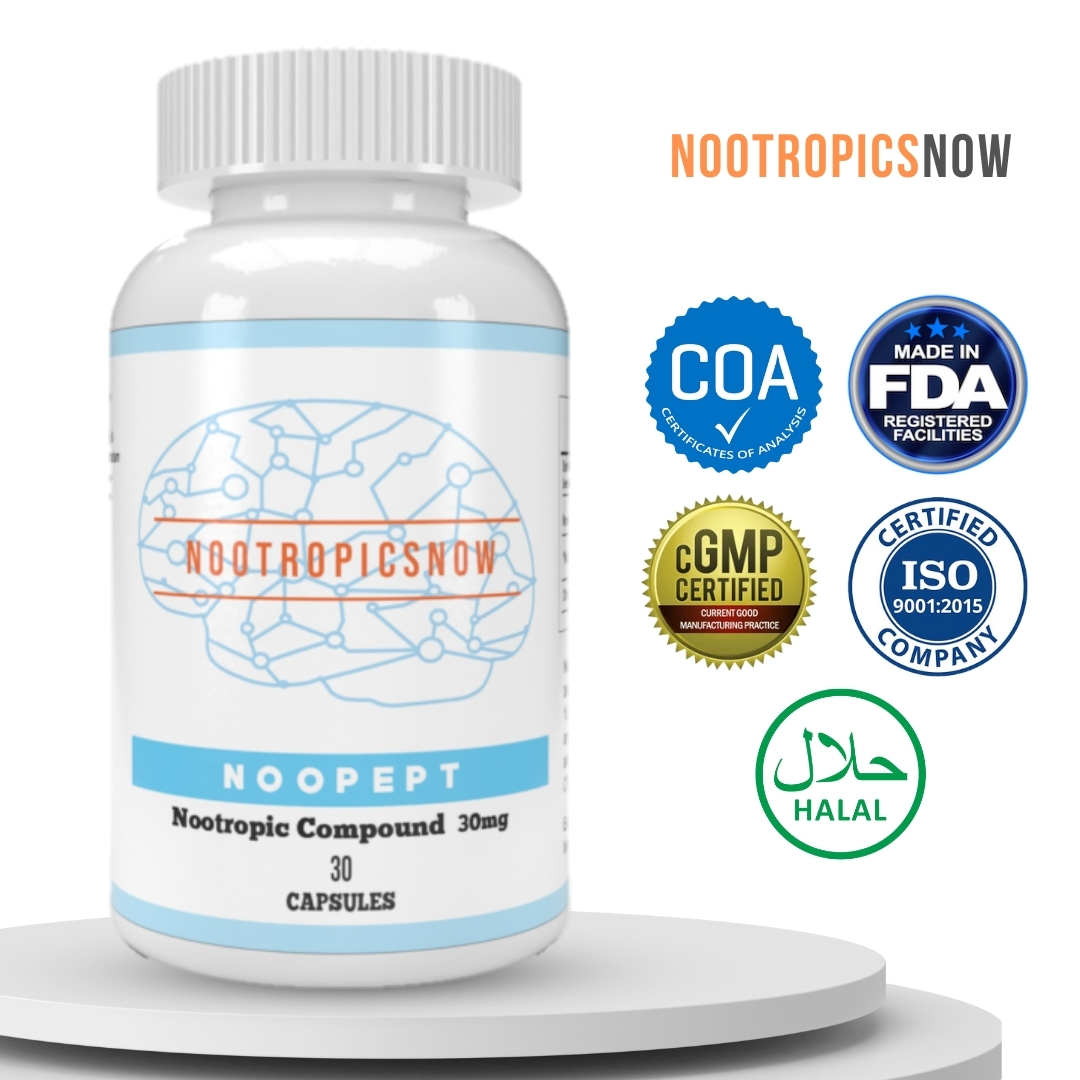Atomoxetine: Nootropic Benefits?

Atomoxetine: A Nootropic Perspective on ADHD Medication
Atomoxetine, widely recognized by its brand name Strattera, represents a non-stimulant medication primarily prescribed for the management of Attention Deficit Hyperactivity Disorder (ADHD). However, its effects on neurotransmitter systems also spark interest within the nootropic community. Although not a typical “smart drug” in the same vein as racetams or ampakines, atomoxetine’s capacity to enhance focus and cognitive control warrants a closer look regarding potential nootropic applications. Therefore, we need to understand its benefits, side effects, and how it compares to traditional nootropics, before we can know how to apply it in the correct context.
Understanding Atomoxetine’s Mechanism of Action

Unlike many ADHD medications that primarily target dopamine pathways, atomoxetine operates as a selective norepinephrine reuptake inhibitor (SNRI). Consequently, the action of atomoxetine specifically focuses on norepinephrine. Norepinephrine plays a pivotal role in various cognitive processes, including attention, vigilance, and impulse control. By selectively blocking the reuptake of norepinephrine in the brain, atomoxetine increases the availability of this neurotransmitter in the synaptic cleft, thus prolonging its effects. This, in turn, may improve focus, attention span, and overall cognitive function. It is very important to consider the differences between targeting dopamine pathways and norepinephrine pathways.
For individuals seeking to explore options that might support cognitive flexibility, consider researching supplements like CDP Choline:

View Product
Cognitive Benefits of Atomoxetine
While primarily used for ADHD, some individuals explore atomoxetine’s cognitive benefits beyond its approved indication.
For those interested in supplements that may support cognitive function, consider exploring options such as:

View Product
However, atomoxetine should not be used for off-label purposes without thorough consideration of safety and potential adverse effects.
Side Effects and Safety Considerations
Like all medications, atomoxetine carries potential side effects that users should be aware of.
The information provided here is for informational purposes only and does not constitute medical advice. Consult with a qualified healthcare professional before using atomoxetine for any purpose.
Atomoxetine as a Nootropic: Ethical and Practical Considerations
The use of atomoxetine as a nootropic raises ethical and practical considerations.
Individuals considering using atomoxetine as a nootropic should carefully weigh the ethical and practical considerations and consult with healthcare professionals to make informed decisions.
Atomoxetine vs. Traditional Nootropics
Atomoxetine differs significantly from traditional nootropics regarding mechanism of action, effects, and safety profile.
Individuals interested in exploring traditional nootropics might consider researching options such as:

View Product
Legal and Regulatory Status of Atomoxetine
The legal and regulatory status of atomoxetine varies across different countries and jurisdictions. In most regions, atomoxetine is classified as a prescription medication, requiring a valid prescription from a licensed healthcare provider for legal procurement. The unauthorized purchase, sale, or distribution of atomoxetine may be subject to legal penalties. Regulations regarding atomoxetine may also vary based on the intended use, such as treatment of ADHD versus off-label cognitive enhancement. Individuals should familiarize themselves with the specific laws and regulations governing atomoxetine in their respective regions to ensure compliance.
Research and Studies on Atomoxetine
While most research on atomoxetine focuses on its efficacy in treating ADHD, some studies have explored its effects on cognitive function in healthy individuals.
Individuals interested in using atomoxetine for cognitive enhancement should critically evaluate the available research and consult with healthcare professionals to make informed decisions.
Conclusion: Evaluating Atomoxetine as a Nootropic
Atomoxetine presents a unique case in the realm of nootropics. While primarily a medication for ADHD, its action on norepinephrine pathways suggests potential benefits for focus and cognitive control. However, its side effects, ethical implications, and regulatory status require careful consideration.
Individuals considering using atomoxetine as a nootropic should weigh the potential benefits against the risks and ethical considerations. A thorough evaluation of individual circumstances, consultation with healthcare professionals, and adherence to legal regulations are essential before embarking on atomoxetine use.
Given the complexities and potential risks, atomoxetine is not recommended for casual or unsupervised use as a nootropic. Instead, it should be reserved for individuals under the guidance of a healthcare professional who can monitor its effects and manage any potential adverse reactions.
Atomoxetine as a Nootropic: An In-Depth Exploration
Atomoxetine, widely recognized by its brand name Strattera, serves primarily as a medication for treating attention deficit hyperactivity disorder (ADHD). While not traditionally classified as a nootropic, it exhibits cognitive-enhancing effects, leading to its usage by individuals aiming to bolster their focus and concentration. This section provides a comprehensive overview of atomoxetine, its mechanism of action, potential benefits, side effects, interactions, and safety considerations.
Understanding Atomoxetine
Definition and Background
Atomoxetine is a selective norepinephrine reuptake inhibitor (SNRI) initially approved by the FDA in 2002 for the treatment of ADHD. Unlike traditional stimulants often prescribed for ADHD, atomoxetine is a non-stimulant medication. This difference is significant, particularly for individuals seeking cognitive enhancement without the risks and side effects associated with stimulants.

View Product

View Product
The medication is available in capsule form and is typically taken once or twice daily.
How Atomoxetine Differs from Stimulants
Stimulants like methylphenidate (Ritalin) and amphetamine (Adderall) increase dopamine and norepinephrine levels in the brain. These neurotransmitters play key roles in attention, focus, and impulse control. Stimulants act rapidly but can also produce side effects such as anxiety, insomnia, and appetite suppression. Atomoxetine, conversely, selectively inhibits the reuptake of norepinephrine. This results in increased norepinephrine levels without directly impacting dopamine. This mechanism provides a more gradual and sustained effect, often leading to reduced side effects compared to stimulants.

View Product
Mechanism of Action: Norepinephrine and Cognition
The Role of Norepinephrine
Norepinephrine is a neurotransmitter involved in various cognitive functions, including attention, alertness, and executive functions. It helps regulate the brain’s ability to focus on relevant stimuli while filtering out distractions. Additionally, norepinephrine influences mood, motivation, and the stress response. By selectively blocking the reuptake of norepinephrine, atomoxetine enhances the availability of this neurotransmitter in the brain, leading to improved cognitive performance.
Impact on Executive Functions
Executive functions encompass a range of cognitive processes essential for goal-directed behavior. These include:
Atomoxetine’s impact on norepinephrine levels can positively influence these executive functions. Users often report improvements in sustained attention, reduced impulsivity, and enhanced working memory capacity. These effects make it a potential tool for individuals seeking to improve their overall cognitive abilities.
The Potential Nootropic Benefits of Atomoxetine
Enhanced Focus and Concentration
One of the primary reasons individuals explore atomoxetine as a nootropic is its ability to enhance focus and concentration. The medication’s effects on norepinephrine levels can lead to improved attention span and a greater ability to stay on task. This benefit is particularly appealing for those struggling with distractibility or difficulty maintaining concentration for extended periods.
Improved Executive Function
Beyond its impact on focus, atomoxetine may also improve various executive functions. This includes enhanced working memory, cognitive flexibility, and impulse control. These improvements can translate to better problem-solving skills, increased productivity, and enhanced overall cognitive performance.
Emotional Regulation
Norepinephrine plays a role in emotional regulation, and atomoxetine may help stabilize mood and reduce emotional lability. Some users report experiencing greater emotional resilience and a decreased tendency to become overwhelmed by stress. While not a primary antidepressant, atomoxetine’s impact on norepinephrine can have a positive effect on mood regulation.
Cognitive Enhancement for ADHD and Beyond
While FDA-approved for ADHD, some individuals without ADHD use atomoxetine off-label for cognitive enhancement. However, research on the effects of atomoxetine in individuals without ADHD is limited. It is important to note that the potential benefits may not be as pronounced in individuals who do not have an underlying norepinephrine deficiency.
Side Effects and Safety Considerations
Common Side Effects
Atomoxetine is generally well-tolerated, but it can cause side effects in some individuals. Common side effects include:
These side effects are typically mild and transient, but they can be bothersome for some users. It is essential to be aware of these potential side effects before starting atomoxetine and to discuss any concerns with a healthcare provider.
Serious Side Effects
Although rare, atomoxetine can cause more serious side effects. These include:
If any serious side effects occur, it is crucial to seek immediate medical attention.
Contraindications and Precautions
Atomoxetine is contraindicated in individuals with certain medical conditions, including:
Additionally, atomoxetine should be used with caution in individuals with:
Risk of Suicidal Thoughts
One of the most concerning safety considerations associated with atomoxetine is the increased risk of suicidal thoughts or behavior, particularly in children and adolescents with ADHD. This risk is similar to that seen with other ADHD medications, including stimulants. It is crucial for parents and caregivers to monitor children and adolescents taking atomoxetine for any signs of depression, anxiety, or suicidal ideation.
Drug Interactions
MAOIs
Atomoxetine should never be taken with monoamine oxidase inhibitors (MAOIs). This combination can lead to a dangerous condition called serotonin syndrome, characterized by high fever, muscle rigidity, altered mental status, and autonomic instability. MAOIs should be discontinued at least two weeks before starting atomoxetine.
CYP2D6 Inhibitors
Atomoxetine is metabolized by the CYP2D6 enzyme in the liver. Strong CYP2D6 inhibitors, such as paroxetine, fluoxetine, and quinidine, can increase atomoxetine levels in the blood, potentially leading to increased side effects. The dosage of atomoxetine may need to be adjusted in individuals taking these medications.
Blood Pressure Medications
Atomoxetine can interact with blood pressure medications, both increasing and decreasing their effectiveness. It should be used cautiously with antihypertensive agents and indirect-acting sympathomimetics. Regular monitoring of blood pressure is recommended.
Other Medications
Atomoxetine can also interact with other medications, including:
It is essential to inform your healthcare provider about all medications you are taking before starting atomoxetine.
Dosage and Administration
Starting Dose
The typical starting dose of atomoxetine for adults is 40 mg per day. This dose is usually increased gradually over several weeks to the target dose of 80 mg per day. The maximum recommended dose is 100 mg per day.
Maintenance Dose
The maintenance dose of atomoxetine varies depending on individual response and tolerability. Some individuals may benefit from a lower dose, while others may require the maximum dose. The dosage should be adjusted under the guidance of a healthcare provider.
Administration
Atomoxetine can be taken once or twice daily. When taken once daily, it is typically administered in the morning. When taken twice daily, the doses should be spaced approximately 12 hours apart. Atomoxetine can be taken with or without food.
Special Populations
The dosage of atomoxetine may need to be adjusted in certain populations, including:
Legal and Ethical Considerations
Prescription Requirement
Atomoxetine is a prescription medication and cannot be obtained legally without a prescription from a licensed healthcare provider. This is due to the potential for side effects and drug interactions.
Off-Label Use
Using atomoxetine for cognitive enhancement in individuals without ADHD is considered off-label use. While this is not illegal, it is important to be aware of the potential risks and benefits. Off-label use should be discussed with a healthcare provider.
Ethical Considerations
The use of atomoxetine for cognitive enhancement raises ethical questions, particularly in competitive environments such as academics or professional settings. There are concerns about fairness and the potential for coercion. It is important to consider these ethical implications before using atomoxetine for cognitive enhancement.
Alternatives to Atomoxetine
Stimulant Medications
Stimulant medications, such as methylphenidate (Ritalin) and amphetamine (Adderall), are commonly prescribed for ADHD. These medications can also enhance cognitive function but are associated with a higher risk of side effects and potential for abuse.
Non-Stimulant Medications
Besides atomoxetine, other non-stimulant medications for ADHD include guanfacine (Intuniv) and clonidine (Kapvay). These medications work through different mechanisms than atomoxetine and may be better suited for some individuals.
Natural Nootropics
Many natural nootropics are available that can enhance cognitive function. These include:
View Product
View Product
View Product
These natural nootropics are generally well-tolerated and have fewer side effects than prescription medications.
Conclusion
Atomoxetine, while primarily a medication for ADHD, has garnered attention as a potential nootropic due to its ability to enhance focus, concentration, and executive functions. Its selective action on norepinephrine offers a different approach compared to traditional stimulants. However, potential users should be aware of the side effects, drug interactions, and safety precautions associated with atomoxetine. It is essential to consult a healthcare provider before considering atomoxetine for cognitive enhancement, particularly to assess individual risks and benefits. Alternative options, including other medications and natural nootropics, should also be considered. With careful consideration and medical guidance, individuals can make informed decisions about whether atomoxetine is a suitable option for their cognitive enhancement goals.

